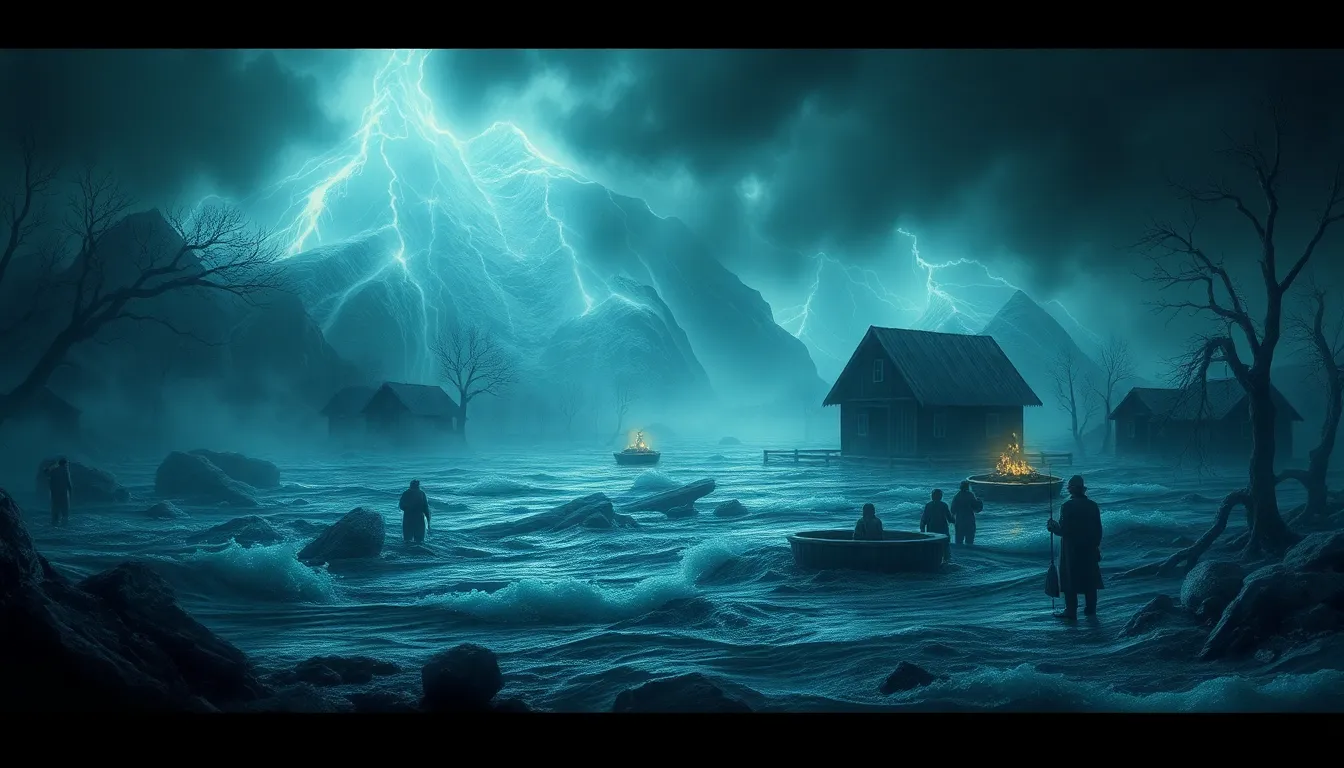The Role of Community in Flood Myths: Tales of Unity and Survival
I. Introduction
Flood myths are narratives found across various cultures that describe cataclysmic floods, often as a form of divine punishment or a means of renewal. These stories, ranging from the Epic of Gilgamesh to the Biblical account of Noah’s Ark, reflect the human experience of catastrophe and the resilience of communities in the face of overwhelming challenges.
The significance of flood myths lies not only in their dramatic retellings but also in their underlying messages about unity, survival, and the role of community during crises. In these narratives, we often see groups of people coming together, sharing resources, and supporting one another in their struggle for survival.
This article explores the integral role of community in flood myths, examining historical contexts, symbolism, and the lessons these ancient tales teach us about modern disaster preparedness and community resilience.
II. Historical Context of Flood Myths
A. Origins of flood myths in ancient civilizations
Flood myths can be traced back to some of the earliest human civilizations. Many ancient cultures, including the Sumerians, Babylonians, and Indigenous peoples, developed their own flood narratives, each reflecting their unique environmental challenges and societal values.
B. Common elements and themes across different cultures
Despite the geographical and cultural differences, flood myths often share common elements:
- A great flood sent by deities or nature as punishment for human sins.
- A chosen individual or group who survives in a vessel or through divine intervention.
- The eventual rebirth of humanity and the earth following the flood.
C. The impact of geography and environment on flood narratives
The geographical context greatly influences the narratives of flood myths. For instance, societies near large rivers often had myths based on real flood events, which were then woven into their cultural fabric, reflecting their relationship with the land.
III. Symbolism of Water in Flood Myths
A. Water as a symbol of destruction and rebirth
Water in flood myths embodies duality—representing both destruction and rebirth. While floods can obliterate communities, they also create opportunities for renewal and regeneration of the earth.
B. The dual nature of floods: danger and renewal
This duality creates a rich tapestry of meaning where floods serve as a catalyst for change. Communities often emerge stronger, with newfound respect for nature’s power and a commitment to collaboration.
C. Community responses to the symbolism of water
Communities often respond to the symbolism of water through rituals and ceremonies that honor the balance between human existence and nature’s force, emphasizing the need for harmony and preparedness.
IV. Case Studies of Prominent Flood Myths
A. The Epic of Gilgamesh: Unity in the face of catastrophe
The Epic of Gilgamesh features a flood sent by the gods, but it also highlights the bond between Gilgamesh and his friend Enkidu. Their journey together showcases the importance of companionship and teamwork in overcoming adversity.
B. The story of Noah’s Ark: Divine intervention and community survival
Noah’s Ark is perhaps one of the most recognized flood myths, emphasizing obedience and faith. The narrative showcases Noah’s role as a leader who gathers his family and pairs of animals, symbolizing community and collective survival through divine guidance.
C. The Hindu tale of Manu: Sacrifice and collective resilience
In Hindu mythology, Manu is warned of an impending flood and instructed to build a boat to save himself and the seeds of all living things. This tale emphasizes the themes of sacrifice and the interconnectedness of life, highlighting the importance of community in preserving the future.
V. The Role of Community in Survival Narratives
A. Cooperation and collaboration during disasters
Flood myths often illustrate the necessity of cooperation and resource-sharing during disasters. Communities depicted in these stories unite to face challenges, pooling their skills and knowledge for survival.
B. Shared rituals and collective memory in flood myths
Communities pass down flood myths through generations, creating a collective memory that reinforces social bonds. Shared rituals related to these myths can include commemorative events or festivals that celebrate survival and resilience.
C. The importance of leadership and community organization
Effective leadership is crucial during disasters, as seen in many flood myths. Leaders who emerge in these stories often possess wisdom and courage, guiding their communities towards safety and recovery.
VI. Lessons from Flood Myths for Modern Communities
A. How ancient myths inform contemporary disaster preparedness
Flood myths serve as cautionary tales that remind modern communities of the importance of preparedness. They highlight the need for emergency plans, resource management, and community training.
B. The relevance of community bonds in modern crises
In contemporary society, strong community bonds can significantly impact recovery efforts. Flood myths remind us that unity and collaboration can lead to better outcomes during crises.
C. Case studies of community resilience in recent floods
Recent natural disasters have shown how communities can come together to rebuild and support each other. For instance, after Hurricane Katrina, grassroots organizations mobilized to assist affected residents, echoing themes found in ancient flood myths.
VII. Psychological and Sociological Perspectives
A. The role of myths in shaping community identity
Flood myths contribute to community identity, serving as shared narratives that foster a sense of belonging. They help individuals connect with their heritage and cultural roots.
B. Shared trauma and healing through communal stories
Communal stories of survival can facilitate healing in the aftermath of disasters. They provide a framework for processing shared trauma and reaffirming community bonds.
C. The influence of flood myths on cultural cohesion
Flood myths can enhance cultural cohesion by promoting shared values and collective memory, creating a sense of purpose and unity among community members.
VIII. The Evolution of Flood Myths in Contemporary Society
A. Modern adaptations and reinterpretations of flood myths
Today, flood myths are often reinterpreted in literature, film, and art, reflecting contemporary concerns such as climate change and environmental degradation.
B. The impact of climate change on perceptions of flood narratives
Climate change has altered how communities perceive floods, making these ancient narratives increasingly relevant as modern societies grapple with more frequent and severe flooding events.
C. Community-driven initiatives inspired by flood myths
Inspired by flood myths, many communities have initiated programs focused on disaster preparedness, resilience training, and environmental conservation, reinforcing the lessons of unity and survival.
IX. The Future of Community in the Face of Floods
A. Predictions for the role of community in future flood scenarios
As climate change continues to impact weather patterns, communities will likely play an even more crucial role in disaster response, emphasizing cooperation and resilience.
B. The importance of storytelling in community resilience
Storytelling will remain a vital tool for communities to share experiences, learn from past events, and foster resilience in the face of future floods.
C. Encouraging active participation in local disaster management
Encouraging community members to engage in local disaster management planning can enhance preparedness and strengthen relationships among residents.
X. Conclusion
In conclusion, the significance of community in flood myths is profound. These narratives not only reflect the trials faced by ancient peoples but also offer timeless lessons on unity, resilience, and the human spirit’s capacity to overcome adversity. As we face modern challenges, the stories of our ancestors can guide us in building stronger, more interconnected communities capable of withstanding the floods of tomorrow.



